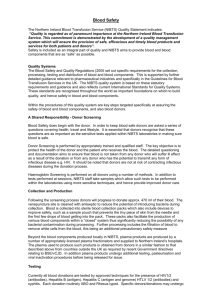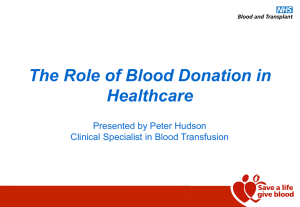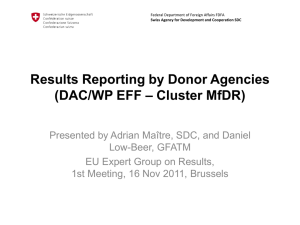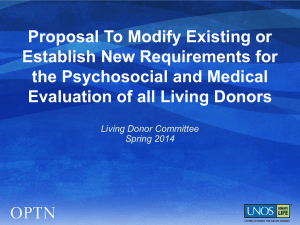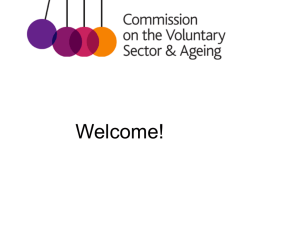15_03a - NHS Blood and Transplant
advertisement
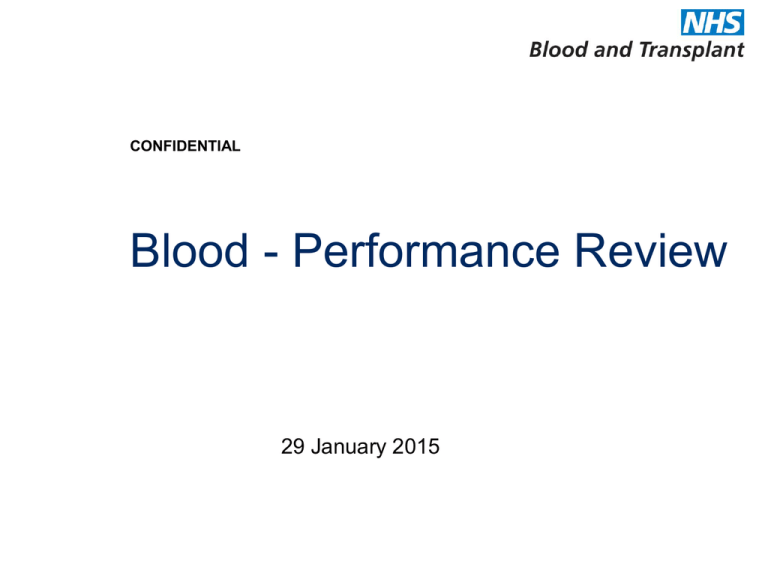
CONFIDENTIAL Blood - Performance Review 29 January 2015 Pillar 1 Blood Donation and the Donor Experience 2 Five blood donation challenges SUFFICIENCY OF SUPPLY Cannot continue meeting demand by increasing frequency of donation only and must move towards a segmented management of the donor base Further MODERNISATION Must modernise our sessions and the way we interact with donors improve the to secure the donor base of the future quality and ORGANISATION / WORKFORCE safety Have an organisation structure fit for purpose and strengthen of our front line management and planning our service CUSTOMER SERVICE to Exceed donors’ customer service expectations by improving patients our session experience and environment and addressing and variation between teams donors EFFICIENCY Change our collection model both in session and out of session to enable a step change in our productivity and have more flexibility to react to demand changes 3 Progress / main milestones achieved in Challenges 1 and 2 Strategic initiatives Progress/ Main milestones Segmented management of donors by blood group Targets for O neg set and tracked monthly; Donor Plus (on-call) in place (5% signed up); Appointed “product manager” for O neg Slow down rate of decline of O neg donor base Sufficiency Interval Study Donor Portal Modernize O neg donor base declining slower than overall donor base but below plan; marketing plan in place; exploring double dose red cells Recruitment target of 50,000 achieved; results expected early 2017 Launched end of Nov’13; c550,000 donors registered (150k target in first 12 months) Donor Portal 2 to enhance and strengthen the portal is ongoing (end by Q3 2015) Modern Paperless Donor Journey Project in Discovery Phase; supplier appointed New donors awards Launched in July 2014 with limited complaints from donors Connected sessions 4G ipads now distributed to blood collection teams; smartphones by July/Aug. 4 Progress / main milestones achieved in Challenge 3 BDOD – Majority of the new organizational structure now implemented as planned with no disruption to blood supply Pending roll-out of MAPS North Region (“go live” Feb’15) and new clinical & nursing structure Project forecast to exceed the expected costs savings (£5,412k in OBC vs. current forecast of £5,775k) Non recurring costs forecast to be lower than plan (£9,924k in OBC vs. £8,905 forecast) Cultural change: action plan and leadership commitments agreed and tracked at SMT every 2 months Effective performance mgment “Smarter” planning Scorecards for Ops&Nursing now live and being used by teams Scorecards for Marketing being developed Performance management has been part of BDOD training Improvement of planning tools and skills will be linked to the new Planning and Control Systems Tools (collections will follow the demand and the manufacturing modules) Appointment of external person to National Planning Manager 5 Progress / main milestones achieved in Challenges 4 and 5 Customer Services Strategic initiatives Progress/ Main milestones Panel Segmentation Delayed due to lack of capacity Staff behaviours c80% of teams now trained on the three phases of Customer Service Improvement; donor satisfaction above target Volunteers Contact details now gathered and stored Initial training sessions to volunteers completed with positive feedback Session Consolidation Stage 1: WEDC/Kings Norton/Leeds went live in April’14 and Oct’14; on track to deliver savings Stage 2 Business Case expected Jan’15 Reducing non donor facing time “Leaner” set up/pack down process being rolledProductivity out nationally, at the same time as the standardization of the planning assumptions Collecting more in static centres Static centres expected to collect c28k more units in 14/15 vs. 13/14 (+15% YOY) Platelets strategy: on track to reduce to 60% CD by end of 2015/16 6 Pillar 2 Manufacturing Operations 7 Manufacturing operations: 4 challenges SUFFICIENCY OF SUPPLY Increase OTIF to 99%, including specialist components Improve ability to meet complex patient requirements Maximise the use of every donation MODERNISATION Increase levels of automation to • Reduce errors • Reduce waste • Increase efficiency of the supply change ORGANISATION/WORKFORCE Embed a culture of quality and safety (zero major) Develop a customer focused, flexible, innovative and multi-skilled workforce EFFICIENCY Further increase processing and testing productivity above 12,000 units/FTE/year and 28,000 units/FTE/year respectively Optimize asset utilisation Further improve the quality and safety of our service to patients and donors 8 Progress / main milestones expected Strategic initiatives Progress/ Main milestones Introduce standard scheduling and manufacturing techniques It will be part of the business case for consolidating the number of processing sites Introduce Planning and Control Sufficiency Systems On track to go live with the demand module and VMI functionality in January 2015 Automation Options for automatic labelling being assessed and piloted in 2015/16 Lean On-going as part of BAU Standardize grading of staff in manufacturing Being completed as part of the business case to consolidate the number of processing sites Personal development plans: quality and safety Expected in 2015/16 Number of majors YTD 0 Modernize Workforce Consolidation of processing sites Target date for business case May/ July 2015 Modernisation of donors records Efficiency Collective consultation completed Recruitment in Manchester & Filton started 9 Performance on strategic targets (1/2) 13/14 actual 14/15 YTD Plan – Month 10 14/15 YTD Actual Month 10 zero days where stock is below 3 days for any blood group 0 0 0 N. of occasions where opening stock of platelets (for any blood group) is below average daily demand 0 0 44* Number of donors donating over the last 12 months 941,458 910,798 901,244 1.90 1.90 1.90 107,854 107,084 105,619 1.98 1.93 1.97 183,676 138,406 131,711 % of donors scoring >= 9/10 in overall satisfaction 67.6% 69.0% 71.0% Complainants per million donations 6,007 5,200 5,661 Blood Donation Strategic Targets Frequency of donation (overall) O neg donors donating over the last 12 months Frequency of donation of O neg donors Donor recruitment * Change to metric vs. last year; now tracked by blood group 10 Performance on strategic targets (2/2) 13/14 actual 14/15 YTD Plan – Month 10 14/15 YTD Actual Month 10 Zero critical and major non compliance at external inspection 6 0 0 Number of faints per 10,000 donors bled 164 160 163 Number of rebleeds per 10,000 donors bled 39 30 33 OTIF 93.4% 96% 94.9% Blood Collection Productivity (units/FTE/year) 1,291 1,352 1,328 Manufacturing productivity 9,423 9,498 9,806 Testing productivity 20,827 22,224 22,935 % of collections in donor centres 10.5% 12.0% 12.9% n.a. 47% 54.2% Blood Donation Strategic Targets % of 9 bed sessions 11 Blood Donation financial performance Total pay and non pay (£m) YOY, % -0.7% -3.5% -3.4% -5.5% -12.5% -10.0% Total WTE, excluding overtime and agency (number, end of year) YOY, % -3.5% -4.2% Over last 3 years, blood donation is on track to deliver: • A reduction of total spend of £9.3m (-7.4%) • A reduction of staff by c390 WTE (-19%) 12 Manufacturing and testing financial performance Total pay and non pay (£m) YOY, % -0.9% -9.5% -1.9% YOY, % 0.5% -5.8% +1.3% -4.5% Total WTE, excluding overtime and agency (number) Over last 3 years, manufacturing and testing is on track to deliver: • A reduction of total spend of £11.6m (-14%) • A reduction of staff by c35 WTE (-4%) -3.7% 13 Pillar 3 Customer Service and the Hospital Interface Hospital satisfaction Hospital feedback is positive but some areas need improvement What do hospitals think of NHSBT? 68% top-box satisfaction score ability to provide a safe, sufficient and cost-effective blood supply is well recognised strong clinical and technical support services educational support / PBM electronic interfaces: OBOS, SPiCE regional variation in satisfaction, large hospitals less satisfied due to more complex needs What do hospitals want to improve? Blood supply Availability of specialist components Manufacturing changes (planning and control improvements, standardised systems, site consolidation, 24/7 working, LEAN): 2015-17 Transport Tailored service for large hospitals TMS 2014, VMI roll-out 2015/16, logistics review 2015 RCI improved turnaround times SPICE - 90% of test results online: 2014 sample logistics pilot: Q2.15 extended working day pilots completed 2014, roll-out 2015 Digital interfaces Improved website: Q3.14 Integrated systems for ordering and invoicing OBOS expansion: Q3.15 Orders to Cash: Q4.16 Targeted customer service intervention In summary Overall, Blood Supply is on track to deliver the strategic initiatives approved as part of Blood Donation Strategy, and planning has commenced to deliver Blood Supply 2020 strategy Over the last 3 years, blood supply is on track to reduce total spend by £20.9m (-11.6%) and staffing by 425 WTEs (-14.6%) which has enabled NHSBT to maintain the price of red blood cells to hospitals; this has been achieved in a context of demand for red blood cells declining by c10% and cost pressures Increased focus and actions are being taken to continue slowing down the decline of the donor base, specially O neg, reduce donors complaints and increase OTIF performance 17

